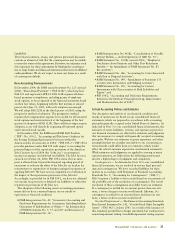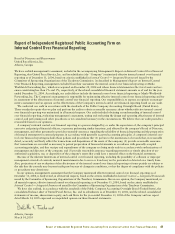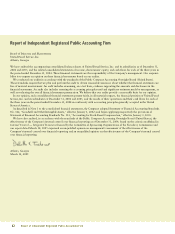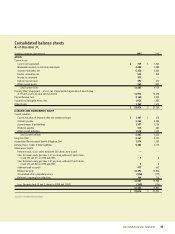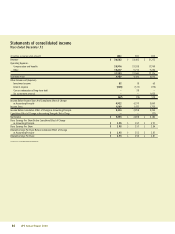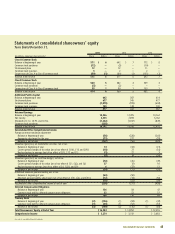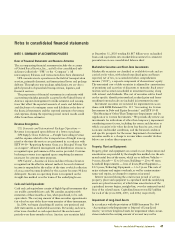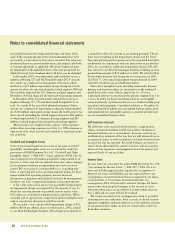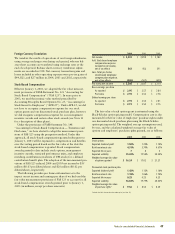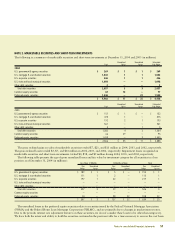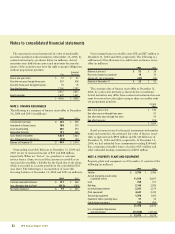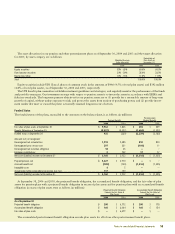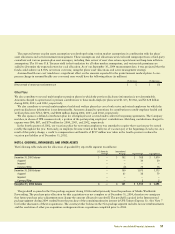UPS 2004 Annual Report Download - page 49
Download and view the complete annual report
Please find page 49 of the 2004 UPS annual report below. You can navigate through the pages in the report by either clicking on the pages listed below, or by using the keyword search tool below to find specific information within the annual report.
Notes to consolidated financial statements 47
Notes to consolidated financial statements
NOTE 1. SUMMARY OF ACCOUNTING POLICIES
Basis of Financial Statements and Business Activities
The accompanying financial statements include the accounts
of United Parcel Service, Inc., and all of its consolidated sub-
sidiaries (collectively “UPS” or the “Company”). All
intercompany balances and transactions have been eliminated.
UPS concentrates its operations in the field of transportation
services, primarily domestic and international letter and package
delivery. Through our non-package subsidiaries, we are also a
global provider of specialized transportation, logistics, and
financial services.
The preparation of financial statements in conformity with
accounting principles generally accepted in the United States of
America requires management to make estimates and assump-
tions that affect the reported amounts of assets and liabilities
and disclosure of contingent assets and liabilities at the date of
the financial statements and the reported amounts of revenues
and expenses during the reporting period. Actual results could
differ from those estimates.
Revenue Recognition
U.S. Domestic and International Package Operations —
Revenue is recognized upon delivery of a letter or package.
UPS Supply Chain Solutions — Freight forwarding revenue
and the expense related to the transportation of freight is recog-
nized at the time the services are performed in accordance with
EITF 99-19 “Reporting Revenue Gross as a Principal Versus Net
as an Agent”. Material management and distribution revenue is
recognized upon performance of the service provided. Customs
brokerage revenue is recognized upon completing documents
necessary for customs entry purposes.
UPS Capital — Income on loans and direct finance leases is
recognized on the effective interest method. Accrual of interest
income is suspended at the earlier of the time at which collection
of an account becomes doubtful or the account becomes 90 days
delinquent. Income on operating leases is recognized on the
straight-line method over the terms of the underlying leases.
Cash and Cash Equivalents
Cash and cash equivalents consist of highly liquid investments that
are readily convertible into cash. We consider securities with
maturities of three months or less, when purchased, to be cash
equivalents. The carrying amount of these securities approximates
fair value because of the short-term maturity of these instruments.
In 2004, we began classifying all auction rate preferred and
debt instruments as marketable securities. Previously, such secu-
rities were classified as cash equivalents if the auction reset
periods were three months or less. Auction rate securities held
at December 31, 2003 totaling $1.887 billion were reclassified
from cash equivalents into marketable securities for consistent
presentation on our consolidated balance sheet.
Marketable Securities and Short-Term Investments
Marketable securities are classified as available-for-sale and are
carried at fair value, with related unrealized gains and losses
reported, net of tax, as accumulated other comprehensive
income (“OCI”), a separate component of shareowners’ equity.
The amortized cost of debt securities is adjusted for amortization
of premiums and accretion of discounts to maturity. Such amor-
tization and accretion is included in investment income, along
with interest and dividends. The cost of securities sold is based
on the specific identification method; realized gains and losses
resulting from such sales are included in investment income.
Investment securities are reviewed for impairment in accor-
dance with FASB Statement No. 115 “Accounting for Certain
Investments in Debt and Equity Securities” and EITF 03-01
“The Meaning of Other-Than-Temporary Impairment and Its
Application to Certain Investments.” We periodically review our
investments for indications of other than temporary impairment
considering many factors, including the extent and duration to
which a security’s fair value has been less than its cost, overall
economic and market conditions, and the financial condition
and specific prospects for the issuer. Impairment of investment
securities results in a charge to income when a market decline
below cost is other than temporary.
Property, Plant and Equipment
Property, plant and equipment are carried at cost. Depreciation and
amortization are provided by the straight-line method over the esti-
mated useful lives of the assets, which are as follows: Vehicles —
9 years; Aircraft — 12 to 20 years; Buildings — 20 to 40 years;
Leasehold Improvements — lives of leases; Plant Equipment —
8 1/3 years; Technology Equipment — 3 to 5 years. The costs of
major airframe and engine overhauls, as well as routine mainte-
nance and repairs, are charged to expense as incurred.
Interest incurred during the construction period of certain
property, plant and equipment is capitalized until the underlying
assets are placed in service, at which time amortization of the
capitalized interest begins, straight-line, over the estimated useful
lives of the related assets. Capitalized interest was $25 million
for each of the years 2004, 2003, and 2002, respectively.
Impairment of Long-Lived Assets
In accordance with the provisions of FASB Statement No. 144
“Accounting for the Impairment or Disposal of Long-Lived
Assets,” we review long-lived assets for impairment when circum-
stances indicate the carrying amount of an asset may not be


